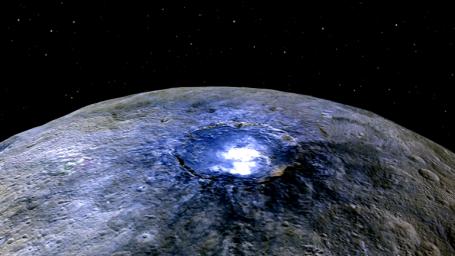Occator in False Color
Caption:
This representation of Ceres' Occator Crater in false colors shows differences in the surface composition. Red corresponds to a wavelength range around 0.97 micrometers (near infrared), green to a wavelength range around 0.75 micrometers (red, visible light) and blue to a wavelength range of around 0.44 micrometers (blue, visible light). Occator measures about 60 miles (90 kilometers) wide.
Scientists use false color to examine differences in surface materials. The color blue on Ceres is generally associated with bright material, found in more than 130 locations, and seems to be consistent with salts, such as sulfates. It is likely that silicate materials are also present.
The images were obtained by the framing camera on NASA's Dawn spacecraft from a distance of about 2,700 miles (4,400 kilometers).
Background Info:
Dawn's mission is managed by JPL for NASA's Science Mission Directorate in Washington. Dawn is a project of the directorate's Discovery Program, managed by NASA's Marshall Space Flight Center in Huntsville, Alabama. UCLA is responsible for overall Dawn mission science. Orbital ATK, Inc., in Dulles, Virginia, designed and built the spacecraft. The German Aerospace Center, the Max Planck Institute for Solar System Research, the Italian Space Agency and the Italian National Astrophysical Institute are international partners on the mission team. For a complete list of acknowledgments, see
http://dawn.jpl.nasa.gov/mission
.
For more information about the Dawn mission, visit
http://dawn.jpl.nasa.gov
.
Cataloging Keywords:
| Name |
Value |
Additional Values |
| Target |
1 Ceres |
|
| System |
Main Belt |
|
| Target Type |
Dwarf Planet |
Asteroid |
| Mission |
Dawn |
|
| Instrument Host |
Dawn |
|
| Host Type |
Orbiter |
|
| Instrument |
Framing Camera (FC) |
|
| Detector |
|
|
| Extra Keywords |
Color, Crater, Infrared |
| Acquisition Date |
|
| Release Date |
2015-12-09 |
| Date in Caption |
|
|
| Image Credit |
NASA/JPL-Caltech/UCLA/MPS/DLR/IDA |
| Source |
photojournal.jpl.nasa.gov/catalog/PIA20180 |
| Identifier |
PIA20180 |

 Planetary Data System
Planetary Data System
